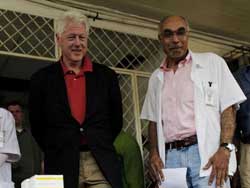Haiti earthquake converts NIH research site into trauma center and refugee camp
February 2010 | Volume 9, Issue 1
“We have done it before, we can do it again. We are the only hope for those who have lost everything."
~ GHESKIO Director Dr. Bill Pape

Photo courtesy of GHESKIO
Haiti's largest HIV/AIDs organization has become
an emergency field hospital and refugee camp,
in addition to continuing its clinical services for
patients with AIDS and TB.

Photo courtesy of GHESKIO
Former U.S. President Bill Clinton visited
GHESKIO recently and discussed aid efforts
with Dr. Pape.
Haiti's largest HIV/AIDs organization has become an emergency field hospital and refugee camp, in addition to continuing its clinical services for patients with AIDS and TB. GHESKIO, a longtime NIH partner and Fogarty grantee, resumed operation two days after the devastating earthquake shook Port-au-Prince.
The organization's buildings suffered structural damage at both its locations but no one was seriously injured. However, four staff were killed elsewhere in the city, several others were critically hurt and 90 are homeless.
GHESKIO director Dr. Bill Pape called the situation "apocalyptic" but says he and his team remain committed to their mission to improve the health of Haiti's poorest people.
"We have done it before and we can do it again," he said. "We are the only hope for those who have lost everything."
After establishing a clean water supply and installing a generator, GHESKIO became the site of a field hospital with supplies and personnel brought in by the U.S. Army and HHS. About a thousand refugees are now living in an open space adjacent to GHESKIO's main operation. Pape says he is struggling to provide adequate food and water for them, in addition to medical care and security.
Since the quake, the majority of the clinic's 6,000 patients with AIDS have returned for their medication and follow up. Many of them are participants in NIH-funded studies, according to Dr. Warren Johnson of Weill Cornell Medical College, who has collaborated with Pape for several decades.
GHESKIO has been providing HIV/AIDS treatment, conducting research and training scientists since 1982 at a downtown site and more recently at a second site on the outskirts of the capital. Perimeter walls were badly damaged at both locations and some structures were rendered unsafe, including a training facility. Johnson says plans are underway to convert a remaining building so that research training can continue.
More Information

Image courtesy of Google
About a thousand refugees are living adjacent to the GHESKIO site in downtown Port-au-Prince.
Description of image: Aerial google-maps generated view of GHESKIO area, blue box shows GHESKIO clinics, red box shows field hospital, yellow box shows refugee camp
To view Adobe PDF files,
download current, free accessible plug-ins from Adobe's website.